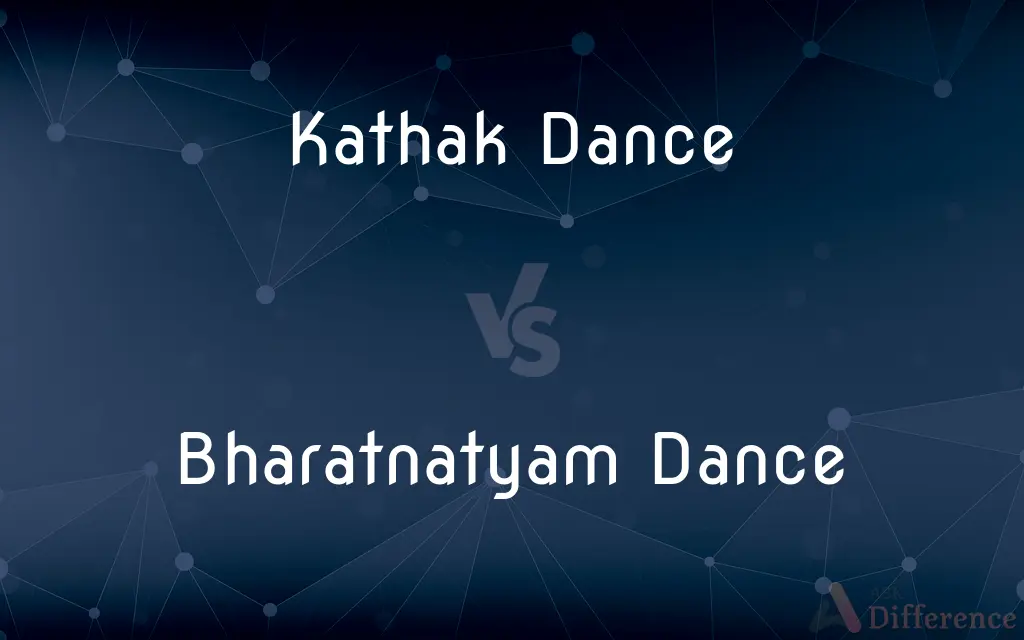Kathak Dance vs. Bharatnatyam Dance — What's the Difference?
By Tayyaba Rehman — Published on December 16, 2023
Kathak Dance is a classical dance form from North India characterized by rhythmic footwork, while Bharatnatyam Dance originates from South India, emphasizing intricate hand gestures and facial expressions.

Difference Between Kathak Dance and Bharatnatyam Dance
Table of Contents
ADVERTISEMENT
Key Differences
Kathak Dance, emanating from North India, is renowned for its storytelling through graceful movements, spins, and rhythmic footwork that resonates with the accompanying music. On the contrary, Bharatnatyam Dance, rooted in South India, is a visual representation of devotional themes, often illustrating ancient Hindu scriptures and poetry.
When observing a Kathak Dance performance, one will witness swift and fluid movements, with an emphasis on footwork and pirouettes. In contrast, a Bharatnatyam Dance captivates its audience with defined geometric patterns, powerful stances, and a myriad of facial expressions interpreting the narrative.
Instrumental accompaniment is pivotal for both dance forms. However, while Kathak Dance typically integrates the tabla (a percussion instrument) to complement its footwork, Bharatnatyam Dance leans on the mridangam (a double-sided drum) and the cymbals, augmenting the dancer's hand gestures and poses.
Costuming and adornment distinguish these dance forms further. Kathak dancers often don long, flowing costumes that accentuate their spins, accessorized with ghungroos (bells) around their ankles. Conversely, Bharatnatyam dancers wear more structured outfits, heavily embroidered and paired with an array of traditional jewelry, emphasizing the intricate movements and expressions.
Comparison Chart
Origin
North India.
South India.
ADVERTISEMENT
Main Features
Rhythmic footwork and spins.
Intricate hand gestures and facial expressions.
Instrumental Accompaniment
Predominantly tabla.
Mridangam and cymbals.
Costuming
Flowing costumes with ghungroos (ankle bells).
Structured, embroidered outfits with traditional jewelry.
Themes
Storytelling, often secular.
Devotional, often illustrating ancient Hindu scriptures and poetry.
Compare with Definitions
Kathak Dance
It often involves storytelling through dance.
The Kathak Dance narrated an ancient legend with grace and fluidity.
Bharatnatyam Dance
The dance form showcases precise geometric movements.
The symmetry and patterns of the Bharatnatyam Dance were a visual delight.
Kathak Dance
Kathak dancers wear ghungroos to accentuate their footwork.
The sound of ghungroos during the Kathak Dance added a magical touch.
Bharatnatyam Dance
It emphasizes hand gestures, poses, and facial expressions.
Every movement in the Bharatnatyam Dance told a different part of the story.
Kathak Dance
The dance form has both secular and devotional renditions.
The Kathak Dance depicted a love story set in a Mughal court.
Bharatnatyam Dance
Bharatnatyam often represents Hindu religious themes.
The Bharatnatyam Dance was a tribute to the goddess Durga.
Kathak Dance
Kathak Dance is a classical North Indian dance form.
The performance of Kathak Dance at the festival was mesmerizing.
Bharatnatyam Dance
Bharatnatyam Dance is a classical dance from South India.
The Bharatnatyam Dance performance depicted a mythological tale with fervor.
Kathak Dance
Kathak Dance emphasizes rhythmic foot movements and spins.
The dancer's footwork in the Kathak Dance was synchronized beautifully with the beat.
Bharatnatyam Dance
Dancers wear traditional costumes and jewelry.
Her attire for the Bharatnatyam Dance was adorned with intricate patterns and jewelry.
Common Curiosities
What kind of stories does Kathak Dance typically narrate?
Kathak Dance often involves storytelling that can be both secular and devotional.
What is the origin of Kathak Dance?
Kathak Dance originated in North India.
Are there any specific costumes associated with Bharatnatyam Dance?
Yes, Bharatnatyam dancers wear structured, embroidered outfits paired with traditional jewelry.
How is Bharatnatyam Dance different from Kathak Dance in terms of movements?
While Kathak Dance emphasizes rhythmic footwork and spins, Bharatnatyam Dance focuses on intricate hand gestures, facial expressions, and geometric patterns.
How significant is footwork in Kathak Dance?
Footwork is a defining characteristic of Kathak Dance, often accentuated by ghungroos (ankle bells).
Which dance form uses ghungroos to accentuate footwork?
Kathak Dance uses ghungroos (ankle bells) to highlight its rhythmic footwork.
Which dance form is older, Kathak Dance or Bharatnatyam Dance?
Both are ancient dance forms, but Bharatnatyam Dance is often considered one of the oldest dance forms in India.
Is storytelling a component of Kathak Dance?
Yes, Kathak Dance often involves storytelling through graceful dance movements.
Are there specific hand gestures associated with Bharatnatyam Dance?
Yes, Bharatnatyam Dance employs a series of intricate hand gestures called "mudras" to convey stories and emotions.
Do both dance forms have their own unique music styles?
Yes, while Kathak Dance typically integrates North Indian classical music, Bharatnatyam Dance is accompanied by Carnatic music from the South.
Which instruments usually accompany a Bharatnatyam Dance performance?
Bharatnatyam Dance typically features instruments like the mridangam and cymbals.
Is Bharatnatyam Dance only religious in theme?
While Bharatnatyam Dance often depicts Hindu religious themes, it can also narrate secular stories.
Can men perform Kathak Dance?
Yes, both men and women can and do perform Kathak Dance.
Which dance form emphasizes more on spins, Kathak Dance or Bharatnatyam Dance?
Kathak Dance is particularly known for its spins and pirouettes.
What kind of jewelry do dancers wear in Bharatnatyam Dance?
Dancers in Bharatnatyam Dance wear traditional jewelry, including necklaces, bangles, earrings, and headpieces.
Share Your Discovery

Previous Comparison
Overdraft vs. Demand Draft
Next Comparison
Single User Operating System vs. Multi User Operating SystemAuthor Spotlight
Written by
Tayyaba RehmanTayyaba Rehman is a distinguished writer, currently serving as a primary contributor to askdifference.com. As a researcher in semantics and etymology, Tayyaba's passion for the complexity of languages and their distinctions has found a perfect home on the platform. Tayyaba delves into the intricacies of language, distinguishing between commonly confused words and phrases, thereby providing clarity for readers worldwide.













































